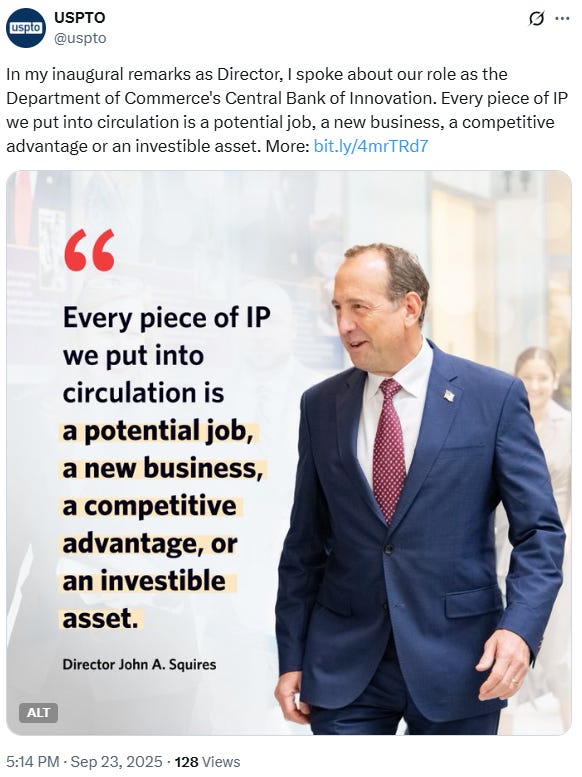New USPTO Director Squires Signals a Pro-Patent, Collaborative Era
"Our role is not to dispassionately say 'no'"
A new chapter began at the United States Patent and Trademark Office (USPTO) with the ceremonial swearing-in of John A. Squires as the 60th Under Secretary of Commerce for Intellectual Property and Director of the USPTO. In his inaugural remarks delivered on September 22, 2025, Director Squires laid out a distinct vision for the agency, one that champions a muscular IP system as a core driver of the American economy and reframes the examination process as a collaborative endeavor. For patent practitioners and IP owners, his speech signals a potentially significant evolution in philosophy and tone from the top of the agency.
Director Squires left no room for ambiguity about his core beliefs. “I firmly and without reservation believe in a strong, robust, expansive, and resilient intellectual property system—and everything that goes with it,” he stated (Remarks, ¶ 10).
This forceful declaration sets a decidedly pro-patent tone for his tenure. The use of the word “expansive” will likely be scrutinized by the IP community, as it may suggest a policy direction favoring broader patent eligibility and protection, a welcome prospect for many innovators and their counsel.
The Examiner’s Role: From Gatekeeper to Negotiator
Perhaps the most notable new concept introduced by Director Squires was his reframing of the patent examiner’s function. Drawing on his background on Wall Street, he proposed a paradigm shift from an adversarial process to one of “claims discovery.” He explained:
As to patents, armed with full disclosure and a clear understanding of the prior art and its applicability—our charge in examination is to identify the line where the prior art ends and the applicant’s inventive contribution begins. And as to that line, we are not judges in an adversarial system. We are seasoned negotiators—on behalf of the American people—working with inventors or brand owners seeking their new and the next to discern the contours, shape, and definition of their claims to ownership—fairly, faithfully, and well documented. Our role is not to dispassionately say “no,” but to engage and help find the “yes” that is properly bounded by law (¶ 16).
To illustrate this, he offered an analogy:
Let me propose an analogy. As you may know, I come from spending considerable time on Wall Street—and there, in a market exchange, the difference between bid/ask is called “price discovery.” For patents, we can begin to think of that space between the prior art and the inventive concept as effectively “claims discovery.” What do I mean by that? The line—the line where the prior art leaves off and where the inventive contribution begins. That’s a bona fide value proposition—disclosure for exclusivity, incarnate (¶ 17).
This perspective suggests a move towards a more interactive and constructive prosecution process, where examiners are empowered to work with applicants to identify and define patentable subject matter, rather than simply issuing rejections.
This approach, if successfully implemented, could lead to more efficient prosecution and potentially stronger, more well-defined patents.
An Economic Engine: The USPTO as the ‘Central Bank of Innovation’
Director Squires also emphasized the USPTO’s critical role in the national economy. He characterized the agency as more than just an administrative body, calling it “a strategic arm of national economic policy” and the “Department of Commerce’s Central Bank of Innovation” (¶ 11).
This economic focus aligns with the support he acknowledged from Commerce Secretary Howard W. Lutnick, himself an inventor, and the President who is “committed to strong action to ‘protect the promise of American innovation’” (¶ 8).
By framing every granted patent or registered trademark as a potential job, business, or investible asset, Director Squires elevates the agency’s mission, linking the daily work of examiners directly to national prosperity.
“When we protect ideas and identities well, we build industries,” he asserted. “When we do it consistently, we build confidence” (¶ 26).
Thoughts and Analysis
The vision articulated by Director Squires presents clear benefits for IP stakeholders. A Director who believes in an “expansive” IP system is likely to advocate for policies that strengthen patent rights.
The concept of “claims discovery” could streamline patent prosecution, reduce the number of office actions, and foster a more predictable and collaborative environment between applicants and the examining corps. This philosophical alignment from the top could invigorate the agency and reinforce the value of IP rights across the government.
The primary challenge lies in implementation. Shifting the culture of a 14,000-person agency is a monumental task. Transforming examiners from adjudicators into “seasoned negotiators” will require significant training, new performance metrics, and sustained leadership.
In addition to current concerns in wake of the abolishment of their union, there may be internal resistance to altering long-established examination practices. Furthermore, the call to “innovate internally” and “make the best use of data and technology” (¶ 23) hints at the integration of advanced tools, likely including AI.
While a pro-patent stance is welcome to many, an “expansive” approach could reignite debates over patent quality and enforcement. Critics may worry it could lead to the issuance of overly broad patents, potentially stifling innovation and increasing litigation. On the technology front, the push for new tools brings inherent risks.
The agency must proceed with caution, ensuring that any new technological aids are secure, reliable, and supplement—rather than supplant—the expert judgment of human examiners.
Looking Forward
Director Squires has articulated an ambitious and optimistic vision for the USPTO. His message is one of partnership, economic vitality, and a shared mission to foster American ingenuity.
For patent attorneys, in-house counsel, and inventors, his tenure begins on a promising note, signaling an administration that views strong IP protection as foundational to the nation’s success.
The IP community will be watching closely to see how this compelling vision translates into tangible policy changes and day-to-day practice at the Office.
As the new Director said in closing, “There is much to do” (¶ 28).
Disclaimer: This is provided for informational purposes only and does not constitute legal or financial advice. To the extent there are any opinions in this article, they are the author’s alone and do not represent the beliefs of his firm or clients. The strategies expressed are purely speculation based on publicly available information. The information expressed is subject to change at any time and should be checked for completeness, accuracy and current applicability. For advice, consult a suitably licensed attorney and/or patent professional.




